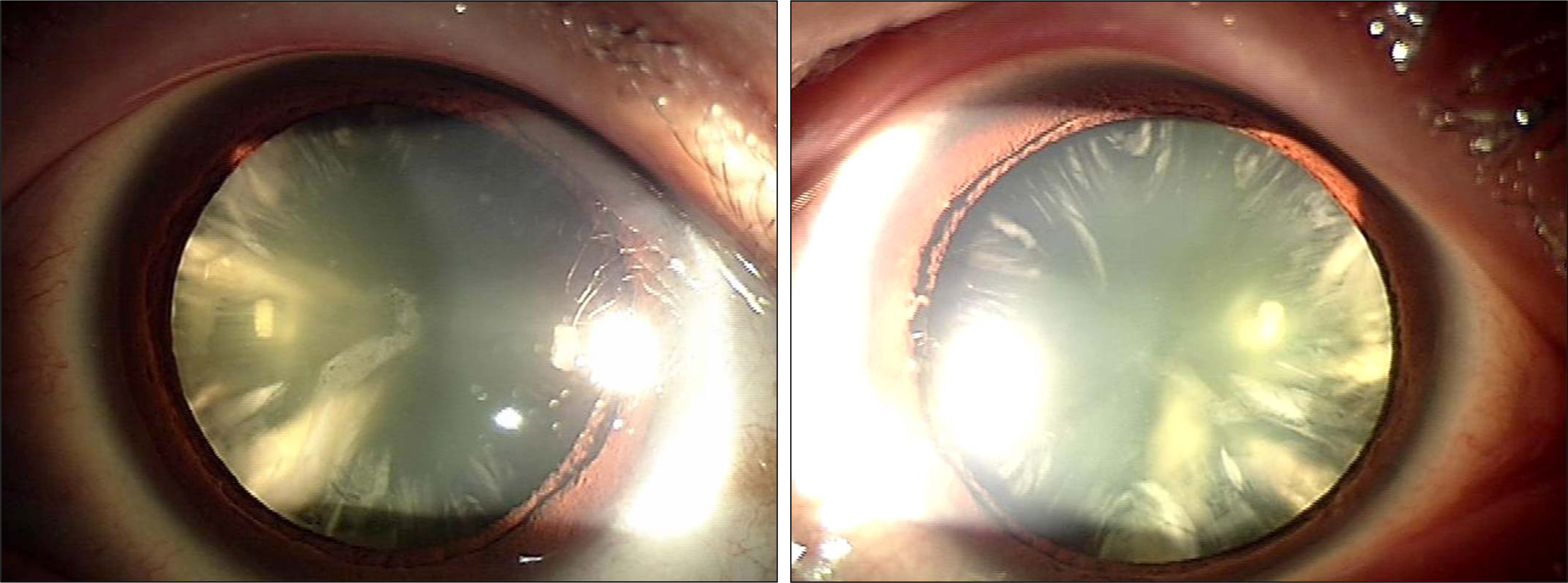J Korean Ophthalmol Soc.
2011 Dec;52(12):1541-1544. 10.3341/jkos.2011.52.12.1541.
A Case of Cataract after Long-Term Use of Clonazepam in a Young Patient
- Affiliations
-
- 1Department of Ophthalmology, Seoul Paik Hospital, Inje University College of Medicine, Seoul, Korea. hyuny@medimail.co.kr
- 2Department of Ophthalmology, Sanggye Paik Hospital, Inje University College of Medicine, Seoul, Korea.
- KMID: 2215163
- DOI: http://doi.org/10.3341/jkos.2011.52.12.1541
Abstract
- PURPOSE
To report a case of cataract after long-term use of clonazepam in a young patient, with a similar appearance to cataract induced by other psychotropic agents.
CASE SUMMARY
A 37-year-old woman complained of a visual disturbance in both eyes. The best-corrected visual acuity was 0.8 in the right eye and 0.6 in the left eye. Bilateral cortical cataract was observed on slit-lamp examination, and no other ophthalmic abnormalities were found. Potential risk factors for cataract were investigated, including past medical and family history, revealing a 20-year history of oral clonazepam (0.5-1 mg/day), for the neurological diagnosis of "chorea of unknown etiology". Detailed medication history did not reveal long-term use of any other drugs which could have induced the cataract.
CONCLUSIONS
Because clonazepam use may induce cortical cataract, regular ophthalmologic examinations are necessary during long-term oral psychotropic therapy.
Keyword
MeSH Terms
Figure
Cited by 1 articles
-
A Case of Clozapine-induced Corneal and Lenticular Pigmentation
Ji Seon An, Young Mi Lee, Joo Young Kwag, Joo Hyun, Jin Seok Choi, Kyu Hong Pak, Sung Kun Chung
J Korean Ophthalmol Soc. 2019;60(3):276-279. doi: 10.3341/jkos.2019.60.3.276.
Reference
-
References
1. Yoon JS, Kim SW. Anxiolytics and hypnotics. Lee HS, editor. Clinical Neuropsychopharmacology. Seoul: ML Communications;2009. 2:chap. 10.2. Shahzad S, Suleman MI, Shahab H, et al. Cataract occurrence with antipsychotic drugs. Psychosomatics. 2002; 43:354–9.
Article3. Razeghinejad MR, Nowroozzadeh MH, Zamani M, et al. In vivo observations of chlorpromazine ocular deposits in a patient on long-term chlorpromazine therapy. Clin Experiment Ophthalmol. 2008; 36:560–3.4. Richa S, Yazbek JC. Ocular adverse effects of common psychotropic agents. CNS Drugs. 2010; 24:977.
Article5. Li J, Tripathi RC, Tripathi BJ. Drug-induced ocular disorders. Drug Saf. 2008; 31:127–41.
Article6. Kim JH. Toxic cataract. Department of Ophthalmology, Catholic University. Cataract. revised ed.Seoul: Ilchokak;2008. 1:chap. 6.7. Kim YH. Neural signal transduction. Lee HS, editor. Clinical Neuropsychopharmacology. Seoul: ML Communications;2009. 1:chap. 2.8. Souza VB, Moura Filho FJ, Souza FG, et al. Cataract occurence in patients terated with antipsychotic drugs. Rev Bras Psiquiatr. 2008; 30:222–6.9. Isaac NE, Walker AM, Jick H, at al. Exposure to phenothiazine drugs and risk of cataract. Arch Ophthalmol. 1991; 109:256–60.10. Deluise V, Flynn J. Asymmetrical anterior segment changes induced by cholorpromazine. Ann Ophthalmol. 1981; 8:953–5.11. Borovik AM, Bosch MM, Watson SL. Ocular pigmentation associated with clozapine. Med J Aust. 2009; 190:210–1.
Article12. Bar S, Feller N, Savir H. Presenile cataracts in phenytoin-treated epileptic patients. Arch Ophthalmol. 1983; 101:422–5.
Article13. Hadjikoutis S, Morgan JE, Wild JM, Smith PE. Ocular complications of neurological therapy. Eur J Neurol. 2005; 12:499–507.
Article14. Butler PA. Reversible cataracts in diabetes mellitus. J Am Optom Assoc. 1994; 65:559–63.15. Zhang F, Löfgren S, Söderberg PG. Interaction of anaesthetic drugs and UV-B irradiation in the anterior segment of the rat eye. Acta Ophthalmol Scand. 2007; 85:745–52.
Article16. Etminan M, Mikelberg FS, Brophy JM. Selective serotonin reup-take inhibitors and the risk of cataracts. Ophthalmology. 2010; 117:1251–5.
Article17. Park KI, Chung JM. Cataract following long-term use of carbama-zepine in young adult. J Korean Neurol Assoc. 2010; 28:127–8.18. Kinoshita A, Kitaoka T, Oba K, Amemiya T. Bilateral drug-induced cataract in a patient receiving anticonvulsant therapy. Jpn J Ophthalmol. 2004; 48:81–2.
Article


